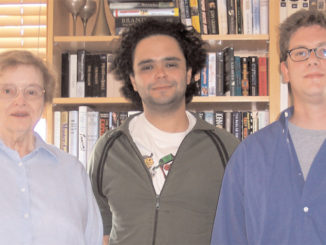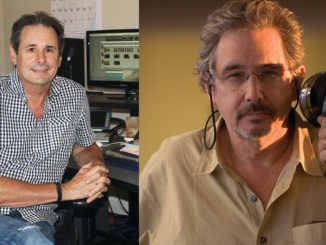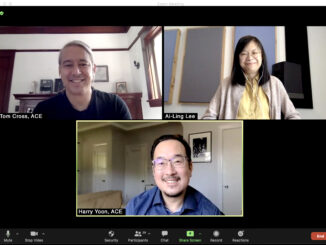
by Laura Almo • portraits by Wm. Stetz
When Jacques Gravett, ACE, first started working in television, any talk of diversity in Hollywood was a long way off. The industry was comprised of mainly men, most of them white. Gravett says he found his way by working hard, getting to know people in the business and continually honing his craft so that when an opportunity did come, he was ready.

“I was able to climb the ladder by building my own ladder,” reflects Gravett, whose credits include episodes of the TV series Carnivale (2003-2005), Battlestar Galactica (2004-2009), The Shield (2002-2008), Sons of Anarchy (2008-2014), Being Mary Jane (2013-present), Chicago Justice (2017), Shots Fired (2017), 13 Reasons Why (2017-present) and the new series Love Is_. “I built my own path. I got to know people. I took classes and, as people got to know me, they understood that I was serious about the business and that I was good at what I did. There was nobody who said, ‘Hey, this is the way to do it; this is where you need to go.’”
Gravett’s path to editorial was very much a practical decision. After graduating from San Diego State University with a degree in business administration and an emphasis in management, the LA native moved back home with aspirations of getting back into the film industry. As a child, he had gotten a taste of “the business” working on a few commercials, which was uncommon for an African-American kid back then. Gravett had loved the excitement of being on a studio lot seeing movies and TV shows being made, so as an adult he wanted to start a career in Hollywood.
Naively assuming he would use his newly minted business degree to get into the industry, he finally scored a job as a page at Paramount Studios. Six months later, he got a gig as a PA. “I took that opportunity and made the most of it,” recalls Gravett, who, because he hadn’t gone to film school, treated his PA position as his own personal film school.
Settling in at Paramount, Gravett worked on the Star Trek franchise, which turned out to be a boon for him as the studio was spinning off multiple related shows and there were many opportunities for a diligent, serious PA. “I decided to get into editing because I thought it was going to be one of the best routes to keep moving up in the industry,” he explains. “I was able to spend time with some of the editors on Star Trek: The Next Generation [1987-1994] and Star Trek: Voyager [1995-2001] and got to know a little bit about the cutting room. I also took classes on weekends to learn about editing and read the Avid manual — back when they actually put out books — and practiced a lot.”
It was a conversation with Rick Berman, the executive producer of both The Next Generation and Voyager, that opened the door for Gravett and led to him getting a job at Unitel Video in Burbank (now Level 3 Post), where he accrued enough days required for Editors Guild membership. “I was not afraid to take a lateral move that would eventually help me to make a move forward,” he reflects. Gravett returned to Paramount and worked on six seasons of Star Trek: Voyager as an assistant editor. His first job as an editor was on HBO’s Carnivale. Gravett says he is happy with the broad range of shows he’s been able to work on, especially after working in sci-fi for so long.
CineMontage interviewed Gravett in late April in the run up to Season 2 of 13 Reasons Why, which dropped May 18 on Netflix, and the June 19 premiere of Love Is __ on Oprah Winfrey’s OWN Network.
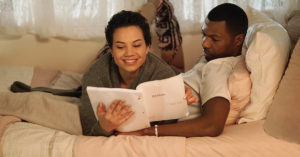
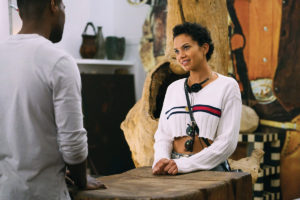
CineMontage: You are the supervising editor on Love Is_, the new dramedy series on OWN, about a black power couple in Hollywood. How did you get involved in this series?
Jacques Gravett: I worked with the producer of Love Is_, Mara Brock Akil, on Being Mary Jane [2013-present; about the life of a young black woman, including her work, family and the popular talk show she hosts], so it’s familiar territory. In this business, you usually get to work with people for one project or a period of time and then everyone moves on. But there are instances in which you get to work with the same people over and over again — and that’s what made this so special. It’s great to be around nice people that care about you and allow you to be creative.
I was on 13 Reasons Why when I got the call from Mara that she was going to be directing the pilot and she wanted me to cut it. Mara is very kind and talented and her husband Salim Akil, who has his own show Black Lightning [2018], is the executive producer on it. They’re a true Hollywood power couple.
CM: What makes this series so unique?
JG: It’s a true story and something that’s rarely seen on television; you know, black love, two African-American people deeply in love, telling the tale of their relationship. And the backdrop is Hollywood and the struggles with that. It’s a story that’s told from their perspective — remembering how they met, how they made it, what worked and what didn’t. Of course, there are some surprises along the way.
CM: What does your work as the supervising editor entail?
JG: As the supervising editor, I’m helping to facilitate the cuts. Right now, we’re a two-editor team with three assistants. The other editor is a woman by the name of Jessie Marion, and the assistants are Kenneth McClendon, Yoni Rusnak and Armen Gasparian. It’s unique in that we’re only two editors, so it’s a little bit more work for us.
Traditionally, you might put a cut together, send it out, wait for the producer to give you that first round of notes, and then keep whittling away. As the supervising editor, I’m able to step in and, because Mara and I have a shorthand of how she likes to work and what she likes, when she comes into the cutting room, or looks at cuts remotely, it’s less for her to have to do.
CM: Among the many shows you’ve worked on, you are particularly proud of Shots Fired, which was also created by a couple. Tell me about it.
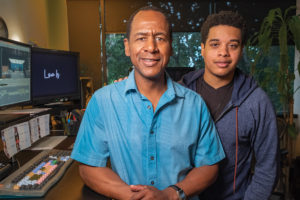
JG: Yes, another Hollywood power couple — Gina Prince-Bythewood and Reggie Rock Bythewood — developed this 10-hour event series. The whole design for Shots Fired was to be like a 10-hour movie. It’s similar to what’s happening on Netflix and other platforms. They’ve always thought of it as a 10-hour movie, and that’s why each show is an “hour” instead of an “episode.”
CM: Shots Fired has been described as “a TV show that aims to reflect the racial tensions and police shooting incidents that have spurred demonstrations and outrage across the country.” Talk about its impetus and what the producers were trying to do with this series.
JG: The story was originally conceived in the aftermath of the Trayvon Martin case when George Zimmerman was found not guilty. One of the things the producers were trying to do was get more eyes and ears on the subject of what’s going on today with police shootings — and of African-American men in particular.
A lot of people probably thought, “Oh, we don’t need to see another one of those shows.” But those things need to be talked about, and if putting something like that on TV can get the conversation going, or keep the conversation going, then that’s what we need to do. The only way that these kind of things can be resolved is if we start talking about them.
CM: You edited three of the series’ “hours,” including Hour 6, “The Fire This Time,” which was directed by the late Jonathan Demme and premiered at Sundance in 2017. What was it like working with him?
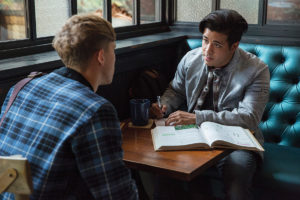
JG: When I saw in the schedule that I was going to be working with Jonathan Demme, of course I was very excited. It was a single-camera show with lots of handhelds. I guess you could call it more documentary-style filming, and they shot on location in North Carolina. He wasn’t able to join me for the editing; after his shoot, he went back to New York. I don’t know if it was because of his health at the time that he didn’t come in, but we worked together via Skype, and it was great.
One of the compliments I got from him was that he was so impressed and amazed at how quickly I was able to put all this footage [from an intense riot sequence] together in such a way that he could basically just sit back and fine-tune what he actually shot for that incredible sequence.
CM: You’re also the lead editor on the second season of the Netflix series 13 Reasons Why…
JG: I was in the lead editor position on 13 Reasons Why, Season 2. I cut episodes 1, 2, 7, 8 and 13, the finale. However, I did not give notes on the episodes I did not cut, like I do now on Love Is_. I worked with some great editors, Philip Harrison and Sue Blainey; also, Leo Trombetta helped me out on the finale. He and I actually had worked together on Carnivale.
CM: The first season of 13 Reasons Why stirred a lot of controversy as it addressed teen suicide, bullying, drunk driving and rape in an explicit way. As a result, Season 2 airs a warning video before the episodes. What were some of the challenges of editing this series?
JG: 13 Reasons Why has a lot going on. Remember high school? There were fun times and bad times. This particular series puts it all out there, and there are some tough things to watch in the second season, for sure. And there were some tough things for me to edit.
CM: Tell me about those things.
JG: Even though Season 2 dropped on May 18, I don’t want to give away any spoilers — but this is what I can tell you. I read the script for episode 13 the night it was sent out. There’s a scene in which one of the characters is bullied in the bathroom at school. It was hard to read; very, very disturbing.
When the dailies came in for that scene, I watched them, but couldn’t cut the scene. I went home. I watched the dailies again the next day, but still didn’t cut the scene. I worked on something else. I spoke to the director, Kyle Alvarez, and gave him my thoughts on the scene. He agreed with my approach to cutting it. Then the following day, I started piecing the scene together. I did it over the course of a couple days because it was so heavy to deal with. My editor’s cut is pretty much what ended up in the show.

CM: But 13 Reasons Why does seems to be a helpful show…
JG: Going back to what we were talking about on Shots Fired, it’s about starting a conversation. It’s letting people have a voice to say, “Hey, you know what? I kind of identify with what this character is going through, so maybe there’s somebody who I can talk to, that can help me out before I do something stupid.” Or, you know, “I saw somebody do something to this person. Let me go talk to someone about it.” It’s helping a lot of people — and that’s what’s getting missed in all the hype on the show.
CM: Speaking of helping people, can you talk about your experience with diversity in the workplace and working with diverse crews?
JG: Diversity is important. Without it, you don’t get the whole picture. We all have differences. We come from different cultural and socioeconomic backgrounds. You can always tell the people in the business that don’t have any diversity in their background because they’re the people who are usually the most insecure around people who aren’t like them.
When I first started, it was not diverse. In television, where I was working, it was all men and very few African-American editors. In fact, at the time, there were only two African-American editors that I knew of working in television.
In terms of crews, I’ve always tried to keep it diverse. In the past seven years or so, the crews of which I’ve been a part have been — well, I won’t say “pretty” diverse because I don’t have the numbers — but there has been diversity in that there have been female editors, female assistant editors, African-American editors and assistant editors, and an Asian assistant.
CM: You are involved with the Editors Guild’s and ACE’s Diversity Committees. Can you talk about that?
JG: At the Editors Guild, we had our first meeting of the year of the African-American Steering Committee in February. The Diversity Committee is broken down into subcommittees, including Pan-Asian, African-American, Latin, LGBT, etc. And those subcommittees each do their own programs and fun activities, to which members are invited in order to mingle and talk about various issues. Basically, it’s to make people aware of diversity concerns. I’m new to the Guild’s committee, so I haven’t seen all the ins and outs of it.
As for ACE [American Cinema Editors], as a Diversity Committee member, I’ve been working with the organization’s mentor program for going on the second year. It’s all about trying to increase awareness and let people know that when they come up against various obstacles in this business, there are quite a few people who have probably been through a similar situation and know a little something about it, so they can help others through it. We meet at various times and talk about whatever issues are relevant: getting started in the business, working in the business, issues that arise, etc. It’s really what the mentees make of it.
CM: Is there any advice you’d like to leave the readers?
JG: This business is tough, and I think it’s important to help others whenever you can. Also, be good at your craft. If you’re good at your craft, hopefully that’ll take care of everything else.



